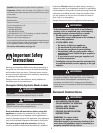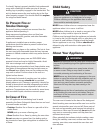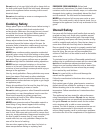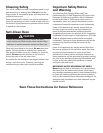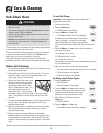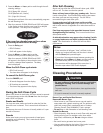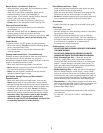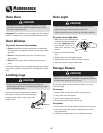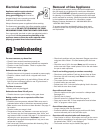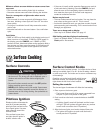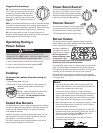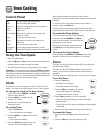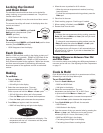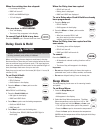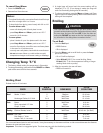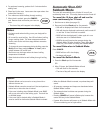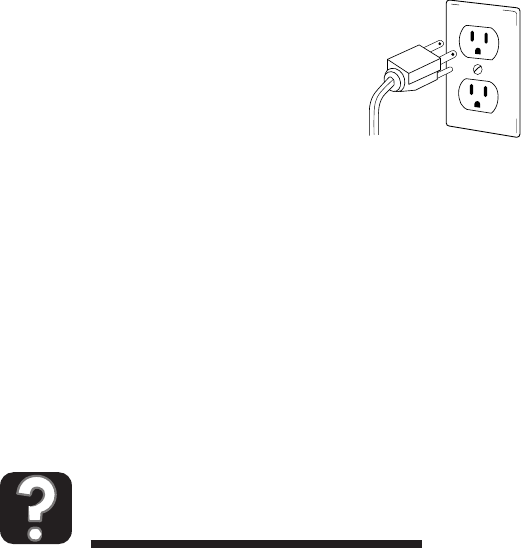
9
Electrical Connection
Appliances which require electrical
power are equipped with a three-
prong grounding plug which must be
plugged directly into a properly grounded
three-hole 120 volt electrical outlet.
Always disconnect power to appliance before servicing.
The three-prong grounding plug offers protection against
shock hazards. DO NOT CUT OR REMOVE THE THIRD
GROUNDING PRONG FROM THE POWER CORD PLUG.
If an ungrounded, two-hole or other type electrical outlet is
encountered, it is the personal responsibility of the
appliance owner to have the outlet replaced with a
properly grounded three-hole electrical outlet.
Removal of Gas Appliance
Gas appliance connectors used to connect this appliance to
the gas supply are not designed for continuous movement.
Once installed, DO NOT repeatedly move this gas appliance
for cleaning or to relocate. If this appliance has to be moved
and/or removed for servicing, follow the procedure described
in the installation instructions. For information, contact
Maytag Customer Assistance at 1-800-688-9900 USA or
1-800-688-2002 Canada.
To prevent range from accidentally tipping, range must
be secured to the floor by sliding rear leveling leg into the
anti-tip bracket.
Troubleshooting
For most concerns, try these first.
• Check if oven controls have been properly set.
• Check to be sure plug is securely inserted into receptacle.
• Check or re-set circuit breaker. Check or replace fuse.
• Check power supply.
Surface burner fails to light.
• Check to be sure unit is properly connected to power supply.
• Check for a blown circuit fuse or a tripped main circuit
breaker.
• Check to be sure ignitor is dry and clicking. Burner will not
light if ignitor is damaged, soiled or wet. If ignitor doesn’t
click, turn control knob OFF.
The flame is uneven.
• Burner ports may be clogged.
Surface burner flame lifts off ports.
• Check to be sure a pan is sitting on the grate above.
Baking results are not as expected or differ from
previous oven.
• Check the oven temperature selected. Make sure oven is
preheated when recipe or directions recommend preheat.
• Make sure the oven vent has not been blocked. See page 17
for location.
• Check to make sure range is level.
• Temperatures often vary between a new oven and an old
one. As ovens age, the oven temperature often “drifts” and
may become hotter or cooler. See page 17 for instructions on
adjusting the oven temperature. Important: It is not
recommended to adjust the temperature if only one or two
recipes are in question.
• Use correct pan. Dark pans produce dark browning. Shiny
pans produce light browning.
• Check rack positions and pan placement. Stagger pans when
using two racks. Allow 1-2 inches between pans and oven
wall.
• Check the use of foil in the oven. Never use foil to cover an
entire oven rack. Place a small piece of foil on the rack below
the pan to catch spillovers.
Food is not broiling properly or smokes excessively.
• Check oven rack positions. Food may be too close to flame.
• Aluminum foil was incorrectly used. Never line the broiler
insert with foil.
• Trim excess fat from meat before broiling.
• A soiled broiler pan was used.
• Preheat oven for 2-3 minutes before placing food in the oven.
• Broil with the oven door closed.
Oven will not self-clean.
• Check to make sure the cycle is not set for a delayed start.
See pages 5-6.
• Check if door is closed.
• Check if control is in Sabbath Mode. See page 16.
• Oven may be over 400° F. Oven temperature must be below
400° F to program a clean cycle.
Oven did not clean properly.
• Longer cleaning time may be needed.
• Excessive spillovers, especially sugary and/or acidic foods,
were not removed prior to the self-clean cycle.
Oven door will not unlock after self-clean cycle.
• Oven interior is still hot. Allow about one hour for the oven to
cool after the completion of a self-clean cycle. The door can
be opened when “LOCK” is not displayed.
• The control and door may be locked. See page 13.



